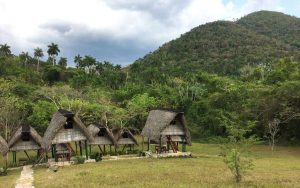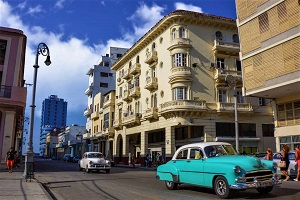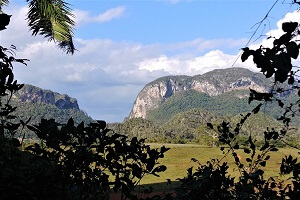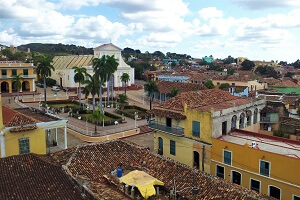Las Terrazas & Soroa
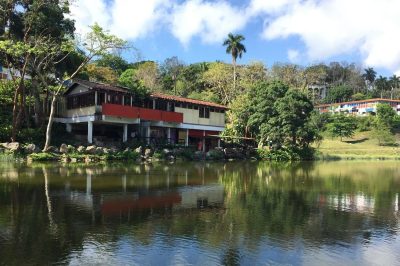
Updated: Dec 19, 2022
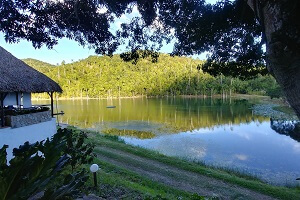
Updated: Dec 19, 2022
About 50 kilometers west of Havana lies the mountainous landscape of the Sierra del Rosario. A large part of the lushly forested mountains has been declared a biosphere reserve by UNESCO. About halfway between Havana and the provincial capital of Pinar del Rio, the eco-centers of Las Terrazas and Soroa are located in the mountains. Both sites are a true natural paradise. Nature lovers and those who want to escape the hot and often chaotic capital can find peace and relaxation in the mountains.
­
Las Terrazas
Nestled in a wonderfully green and hilly landscape, at an altitude of several hundred meters, lies the eco-village of Las Terrazas.
The name of the nature reserve originates from the fact, that terraces had been created in the area for the cultivation of coffee. Until the 1930s, at the height of Cuban coffee production, there were still over 50 coffee plantations in the mountains. However, the terraces led to erosion until ecological collapse was a threat.
In the early 1970s, the Cuban government began a comprehensive reforestation program and, as part of this, also the Las Terrazas eco-village was founded. A total of 1500 kilometers of the former terraces were planted with several million trees on a total area of about 5000 hectares. Since then, people have been living in harmony with nature. The labor force is structured in the form of a cooperative.
The eco-village is especially worth a visit, because it is surrounded by wonderful nature, that invites to a variety of exciting activities. It is a perfect spot for hiking, climbing, cycling or swimming at refreshing natural pools. It is also possible to take boat trips on the lakes or do bird watching. There are also still some historical coffee plantations that can be visited. Travelers looking for some thrill can fly over the lakes and tropical forest while hanging on a zip line.
The Village
The eco-village itself is quite unspectacular. It has about 1000 inhabitants, spread among around 240 families. There is a school, a small hospital and a community square with a souvenir store. In addition, a few simple restaurants can be visited.
In a small store you have the possibility to buy drinks and snacks. A specialty in the meat-eater country of Cuba is the vegetarian restaurant El Romero, from whose balcony one can enjoy a wonderful view of the town and the landscape. An overview of the other localities can be found on the official internet presentation.
­
See & Do
To dive into the wonderful nature, hiking is a great option in the first place. In the area around the ecovillage there are at least six hiking trails to explore. It is possibly to book tours with local guides. A tour gives the advantage that the guides provide important information about the village, animals (mainly birds) and the flora and fauna. In addition, a guide can be helpful, because it is not always easy to orient yourself.
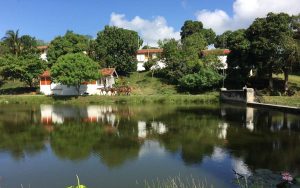 You can rent rowboats and take a swim in different lakes and natural pools.
You can rent rowboats and take a swim in different lakes and natural pools.
If you are looking for a thrill, take the zip line to fly across the valley.
Let's take a closer look at all the different activities available:
Activities:
- If you are looking for a thrill, you can do the Canopy Tour. It goes down the valley hanging on a steel cable for 1.6 km. Definitely nothing for people with fear of heights. Just follow the Canopy signs. Opening hours 9-12 and 13-16. 3 sections: 10 USD; 6 sections: 20 USD and person.
- In a small boathouse you can rent boats for a few dollars and go rowing on the lake.
- As is so often the case in Cuba, there is also the possibility of horseback riding excursions in the beautiful countryside. Prices start at 10 USD and vary according to the duration of the excursions.
- Bicycle lovers who would like to be physically active can rent bikes. However, you should be in good shape, because the landscape is quite hilly. The price is 10 USD per person.
- There are several possibilities to swim. On one hand, there are two lakes and the beautiful natural pools, the Baños de San Juan .
Hiking Trails
- The Serafina trail is 6 kilometers long and leads to an abandoned coffee plantation. So you will visit the ruins of the Santa Serafina coffee plantation. Length: 6.4 Km; Duration: 3 hours; Difficulty: easy-medium; With guide: 20 USD per person.
- The Las Delicias trail leads to the viewpoint of the San Juan Valley. From the viewpoint, 330 meters above sea level, you have a wonderful view of the landscape. On the way down, the path passes by a coffee plantation. Length: 3 Km; Duration: 2 hours; Difficulty: easy-medium; With guide: 20 USD per person (incl. the visit of the plantation).
- The El Terracero trail is especially suitable for bird watching. Length: 2.5 Km; Duration: 2h; Difficulty: low; With guide: 20 USD;
- The El Taburete trail leads to the summit of Mount Taburete (453m). On the summit there is a monument dedicated to Che. From the top you can enjoy a view over the southern part of Artemisa and, with the right conditions, up to the Gulf of Batabano. On the way back, you will pass by the San Juan River, where you can enjoy a bath in the middle of nature. Length: 6 Km; Duration: 3 hours; Difficulty: Medium-High; Excursion with guide: 30 USD per person, including a lunch.
- The El Contento trail heads north. On the hike, you will pass two coffee plantations (San Ildefonso and El Contento). Length: 9 Km; Duration: 3 hours; Difficulty: medium; With guide: 22 USD per person.
- On the Las Terrazas tour, participants will get an insight into the community and the history of the village. In addition, one comes into contact with the residents. At the end of the tour, you will have the opportunity to swim in one of the natural pools. Length: up to 15 km; Duration: 6 hours; Difficulty: low; Guide: 30 USD per person (lunch included)
Points of Interest
- In the former home of Polo Montañez, one of the most important musicians among the Cuban trova, a small museum has been established. Polo Montañez, which is also known as El Guajiro Natural, composed some of his best songs inspired by the natural environment of Las Terrazas.
- The Baños de San Juan are located about 3 kilometers south of the center of the village. Surrounded by tropical forest, you can take a refreshing bath in the emerald green shimmering natural pools on the San Juan River. There is also a small restaurant on the grounds, there you can order typical Cuban meals.
- The former coffee plantation Cafetal Buena Vista is located about 5 kilometers northeast of Las Terrazas. It is located about 240 meters above sea level. A restaurant has been established on the site, from which you can enjoy a beautiful view of the countryside.
- About five kilometers west of the town, you will find the Casa del Campesino, a former farmhouse. Today, the wooden house host a restaurant where you can get typical Cuban food.
- A few kilometers south of the village, there is a Che Guevara monument on the peak of a hill. From the monument you have a wonderful view to the south over the flat landscape of the plain.
­
Accommodation
If you want to stay overnight in Las Terrazas, you have a number of options. The most simple way is to sleep in one of the very basic cottages. If you plan so, you will be exposed to the nature, so better bring a mosquito net. There is also one Hotel and are a number of private accommodations, most of them located a bit outside the village, to choose from:
- The well-managed 3.5-star Hotel Moka is a bit more upscale. From the rooms you enjoy a wonderful view over the village. The hotel was designed to blend harmoniously into the wooded slopes. A tree grows in the lobby, which extends over several floors, and the hotel, which is modeled on the Spanish colonial style, is also otherwise surrounded by dense tropical plants; it is an oasis of peace. In some rooms, branches grow through the walls. Bathrooms have deep soaking tubs adjacent to glass walls, creating a feeling of being very close to nature. There is an outdoor pool and Wi-Fi for 1 USD an hour. Overall, the hotel is something special and worth a visit. Price from 100 dollars, including breakfast.
Casa Particulares (Homestays)
- Villa Maida is one of the few private accommodations that is located close to the center. From the small property you can quickly reach the village center by a short walk. The house is located in the middle of nature. A parking place is available. The landlord is very friendly and helpful. The accommodation is very clean, and if wished, a rich breakfast is served on the terrace.
- About four kilometers east of the village center is Villa Juanita, a Casa Particular, that offers simple but clean and functional rooms. Secure parking is available. Since the house is located just outside Las Terrazas, the accommodation is mainly suitable for travelers with a rental car. However, the owner offers a drop-off and pick-up service for 5 USD each way.
- A quite cheap and clean accommodation option is the Casa Particular Villa Duque. The accommodation is located about four kilometers east of the village center and offers clean and functional rooms. Parking spaces are available. Since the house is located a bit outside of Las Terrazas, the accommodation is primarily suitable for travelers with a car.
- Approximately five kilometers east of Las Terrazas lies the Villa Tres Hermanas.
- About four kilometers east of Las Terrazas is the private accommodation Casa Dona Estrella. The guesthouse offers inexpensive but air-conditioned and clean rooms. The house is located slightly off the road and has a nice tropical garden. There is secure parking on the property.
­
Transport
Las Terrazas is easily reached on a Viazul bus. The connecting between Havana and Pinar del Rio (or Vinales) makes a detour to the ecovillage. The bus leaves Havana at 9 am and arrives at Las Terrazas around 10 am. The fare is 6 USD. Further information in Cuba you find in the article on bus travels in Cuba.
Travelling by cab you should expect, that the trip from Havana will take about an hour and cost around 60-100 USD each way. More details on cab fares can be found in the article about taxis in Cuba
Travelers arriving by rental car will have to pay a fee of 2 USD per person for access to the nature reserve. All you need to know about driving in Cuba can be found in the articles on Car rentals in Cuba.
­
­
Soroa
About 10 kilometers west of Las Terrazas is Soroa, another nature reserve. In Soroa you will find a beautiful botanical garden, where you can admire more than 700 orchid species from all over the world. In addition, there are various hiking trails and a breathtakingly beautiful waterfall. Not only can you visit the waterfall, but you can also take a refreshing bath in a natural pool at the foot of the waterfall. If you want to stay overnight in Soroa, you will find a number of decent accommodations. Soroa can only be reached by rental car or by cab, but not by bus
­
See & Do in Soroa
If you want to enjoy the beautiful nature to the fullest, you should plan at least half a day to visit Soroa.
- In the Orquideario de Soroa, numerous species of orchids and other plants can be found. Among the orchids are rare species such as the Bird of Paradise Orchid, the Flor de San Pedro or the Black Orchid. One third of the plants are endemic. Flowering time is primarily November to May. Overall, it is a beautiful botanical garden in a great location on the hill, with wonderful views. There are also guides. The entrance fee is 3 USD.
- Above the orchid garden lies the Castillo en las Nubes (Castle in the Clouds). The castle was built in the first half of the 20th century by a wealthy landowner. Today the building houses a small hotel. From the terrace you have a unique view over the mountains and the coastal plain, so it is worth visiting even if you are not staying in the hotel. In the hotel you can also use the Internet.
- The Salto de Soroa is one of the most beautiful waterfalls in Cuba. It takes a short walk to reach the feet of the waterfall, where the water plunges almost 30 meters into the depths. The waterfall is popular with locals and tourists at the same time. At the bottom of the waterfall, a natural pool invites to a refreshing swim. There is also a bar where drinks and snacks can be bought. During the dry season, the waterfall and the natural pool are low on water. Therefore, the entrance is 3 or 10 USD, depending on the season. There is a guarded parking lot, that can be used for a small fee (1 USD).
- There is a worth seeing viewpoint, the Mirador Loma el Mogote that one reaches after a quite steep hike (about two kilometers). Once up, you will be rewarded with a fantastic view. The starting point of the hike can be found near the restaurant El Salto. In contrast to the visit to the waterfall, you do not pay an entrance fee.
- You can visit a historic thermal bath in the valley. In the Baños Romanos visitors can bathe in the sulfurous water. For further relaxation, affordable massages are offered.
­
Accommodation
If you want to spend the night in the beautiful nature and relax in the stillness of the place, there are a few accommodations to choose from.
- The Castillo en Las Nubes is a beautiful small hotel with just six rooms but a small pool. It is located in a wonderful landscape and offers a fantastic view. Those who appreciate nature and seek tranquility will spend a wonderful night here.

